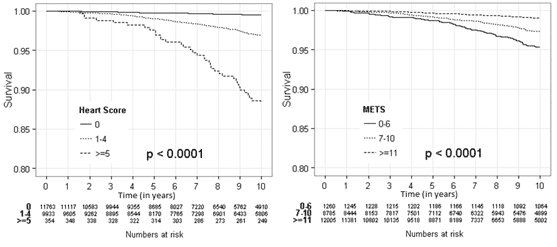Background: The SCORE risk estimation system is used for cardiovascular risk stratification in apparently healthy adults. The purpose of the current study was to evaluate whether exercise capacity can be used to improve the accuracy of the SCORE cardiovascular risk estimation.
Methods: We investigated 22,050 asymptomatic men and women who were annually screened in a tertiary medical center. All subjects were free of ischemic heart disease or diabetes, and had completed maximal exercise stress test according to the Bruce protocol at their first visit. The SCORE risk estimation system was used to evaluate individual cardiovascular risk for all subjects. The primary endpoint of the current analysis was all-cause mortality. The incremental contribution of exercise capacity in predicting the risk of death was evaluated by receiver operating characteristic area under curve (AUC) and net reclassification improvement (NRI).
Results: Mean age of the study population was 47±10 and 71% were men. There were 430 (1.95%) deaths during a mean follow up of 8.8±4.0 years. Kaplan Mayer survival analysis showed that both high SCORE and low exercise capacity are associated with poor survival (FIGURE). When added to the SCORE risk prediction, exercise capacity marginally increased the AUC of the risk model (0.82 vs. 0.80) and significantly improved risk stratification by 13.5% using the NRI approach (P<0.001).
Conclusion: Both SCORE and exercise capacity are strong predictors of all-cause mortality. The addition of exercise capacity to the SCORE risk model can significantly improve the accuracy of the model.


